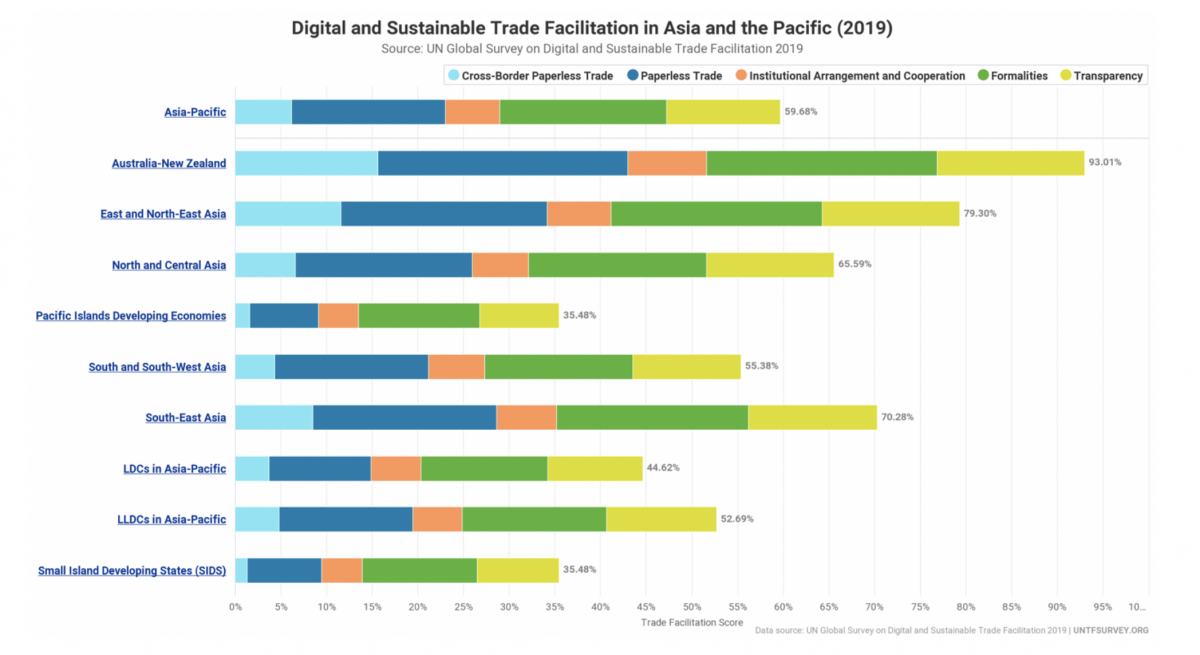|
|
|
Enabling cross-border paperless trade, or the flow and legal recognition of trade-related data and documents in electronic form across borders, has the potential to cut transaction costs by 25% across Asia and the Pacific.
Benefits associated with digitalizing trade procedures also include increased regulatory compliance, reduced illicit financial flows and more effective and inclusive participation in the digital global economy. If those benefits were not enough in themselves, the COVID-19 outbreak has highlighted one more advantage of paperless trade: “contactless” trade. Indeed, paperless trade greatly reduces the need for human-to-human interactions, making it much easier for trade to continue as more and more governments ask people to stay at home to minimize the spread of the virus.
Developing countries, particularly the least developed countries (LDCs), are lagging behind in paperless trade. Institutions and partnerships like the Enhanced Integrated Framework (EIF) and the Economic and Social Commission for Asia and the Pacific (ESCAP) are working together to make sure they are not being left behind in this area.
Paperless trade measures implemented in LDCs
According to the UN Global Survey on Digital and Sustainable Trade Facilitation, LDCs in the Asia-Pacific region have achieved an implementation rate of trade facilitation and paperless trade measures of only 45%, as compared to nearly 60% for the Asia-Pacific region as a whole (see figure). This situation is also true at the global level.
Trade facilitation implementation in Asia-Pacific subregions and countries with special needs

Source: UN Global Survey on Digital and Sustainable Trade Facilitation 2019
LDCs are particularly lagging behind in “contactless” trade facilitation measures.
For example, while electronic submission of customs declarations has generally been enabled and major border posts are equipped with increasingly reliable internet connections, electronic single window systems enabling online submission of all required transaction information to all regulatory agencies through a single portal are still under development. E-payment of customs duties and fees also remains partially implemented. As for cross-border paperless trade measures, such as the electronic exchange among trade partners of certificates of origin or of sanitary and phytosanitary certificates, they remain essentially at the conceptual or pilot stages.
Readiness assessment for paperless trade
As part of a project funded by EIF, readiness assessments for cross-border paperless trade were conducted by ESCAP in the following four LDCs: Bangladesh, Cambodia, Nepal and Timor-Leste. Common challenges identified include:
1. Limited legal rules relevant to paperless trade: The four LDCs examined shared the common problem of having a paucity of domestic legal rules and regulations concerning electronic transactions; and those that do have some notable gaps in their coverage and rigid provisions, as well as some inconsistencies between different legislations. Efforts to modernize and harmonize have started or are being discussed, but still progressing slowly.
2. Lack of electronic systems: Other than customs, the majority of regulatory agencies are not yet equipped with the hardware and software needed for paperless trade (Cambodia is more advanced due to its involvement in the ASEAN Single Window). When quarantine offices do have automated systems, the potential cost and time saving from an electronic customs system is eaten up by delays in the process of acquiring permits.
3. Inadequate coordination between agencies: All LDCs examined have institutional mechanisms relevant to trade facilitation, such as National Trade Facilitation Committees. However, they often do not have the resources or authority to coordinate effectively.This leads to inconsistent and uncoordinated efforts by agencies and other stakeholders.
4. Insufficient human resource capacity: Absent or limited capacity-building activities were identified as one of the main challenges for the four LDCs – spanning various stakeholders involved in international trade such as government officials, trading companies and freight forwarders, IT and database experts.
Planning for action
As part of the readiness assessments, countries constructed initial action plans for cross-border paperless trade. Certain high-priority actions may be fast-tracked, to relieve difficulties faced by traders in relation to the COVID-19 crisis, as well as to ensure that the move towards “contactless” trade continues beyond the crisis.
1. Regulatory agencies should ensure paper documents and cash payments are not requested when electronic documents and payments are already legally and technically acceptable and sufficient. In many countries, officials continue to request paper documents in addition to electronic submission, although legislation is already in place at the national level to ensure equivalence between paper and electronic copies. This may be linked to cultural resistance to change, or to other less acceptable reasons. Regardless, eradicating such practices is possible and very much needed.
2. Governments should take emergency measures to remove legal regulations prohibiting or restricting the use of electronic trade documents, as also noted in the ICC call to governments and central banks. In the long run, the acceptance and exchange of electronic trade-related documents would ensure that countries can reduce trade costs and transaction times. When doing so, it is recommended that international standards and guidelines should be integrated for ensuring interoperability and compatibility. As the situation returns to normal following COVID-19’s disruptions, electronic trade systems and paperless trade frameworks should be fully and regularly reviewed to ensure they are supported by adequate national and agency-level regulations for ensuring the validity of transactions; and to safeguard data protection, privacy and ownership.
3. Governments should not sacrifice nor delay their commitments on ICT infrastructure and paperless trade. Many LDCs have initiated bold actions in this area, such as Digital Bangladesh and Cambodia’s ICT Master Plan 2020. As the Secretary-General of the United Nations, rightfully puts in a report, “everything we do during and after this crisis must be with a strong focus on building more equal and inclusive societies that are more resilient in the face of pandemics, climate change, and the many other challenges we face.”
4. Lastly, governments should continue to engage in global, regional, sub-regional and bilateral initiatives on cross-border paperless trade. This will ensure the national paperless trade initiatives will be easily interoperable with those of neighbouring countries and trade partners. Eligible countries are strongly encouraged to accede to the most recent UN treaty in the area of Trade and Development, the Framework Agreement on Facilitation of Cross-Border Paperless Trade in Asia and the Pacific, to fast track and ensure the sustainability of their trade digitalization while leaving no one behind.
Header image of a currency exchange at Mingaladon International Airport in Myanmar - ©Asian Development Bank via Flickr Creative Commons Attribution-NonCommercial-NoDerivs 2.0 Generic (CC BY-NC-ND 2.0) license.
If you would like to reuse any material published here, please let us know by sending an email to EIF Communications: eifcommunications@wto.org.



